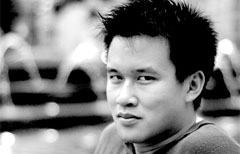
“You guys are my test audience,” said Victor Lin, Stanford Jazz Workshop faculty advisor and star of the night, within the first several minutes of his July 24 “Jazz Meets Classical” concert at Dinkelspiel Auditorium. He wore a half-apologetic smile. Casually dressed down in a two-piece suit, Lin explained the night’s experiment, which was to determine if he could find a synergistic middle ground between jazz and classical music. Previous crossovers had yielded awkward hybrids. Now, the verdict of his attempt –successful or not – rested in the audience’s hands. With a cheeky grin, he urged the audience to clap anyway. Lin divided the concert into bite-sized chunks, and his well-timed humor provided a seamless narrative backdrop for each act, which each featured a classical piece turned jazz. To kick off the concert, Lin gave a jazzy rendition of Chopin’s Prelude Op. 28, No. 1, accompanied by several colleagues onstage. Bassist Josh Thurston-Milgrom fingered a bumblebee thrum underneath Lin’s bouncy chords, while Miles Labat clacked a quick, steady heartbeat on the drums. Lin also paid his respects to great classical pieces like Bach’s “Air on the G String” and Antonio Vivaldi’s “Summer” from “The Four Seasons.” Lin and his accompanists peppered in their own lilts, swinging a verse a little extra and twisting around to dance the remaining notes in a style that was distinctly jazz. But they never strayed too far from the classical framework — they consistently intertwined with each other and looped back to the familiar Bach melody. Perhaps the most memorable act of the night was Lin’s four-man piano venture — which he described as “months of poor planning [and] no execution” — with Mozart’s rapid-fire “Rondo Alla Turca.” Peter Stoltzman, Yuma Sung and a young Cuban pianist joined Lin on two pianos — two people on each instrument — and the rondo began. None of them held back. It was all fingertip punches fueled by the rawest creativity until one pianist abruptly darted to the other piano and squeezed in between the other two players. The audience exploded in laughter. Several more spontaneous switches ensued, but the music somehow pranced on. Following a brief intermission, Lin returned with an eclectic duet-duel with Grammy-winning violinist Mads Tolling. Together, they spun a rich tapestry of improvisation, borrowing from the original “Super Mario Bros” theme song and the trademark “Imperial March” from “Star Wars.” This playful modern tune suddenly swerved into the dark drawls of the classic Hungarian dances, or “Czardas.” Flitting between tempos from sluggish to scorching, Lin and Tolling interjected their own stylistic flairs, masterfully responding to each other’s creations, as they played off similar chord progressions. Lin’s classical jazz was not a one-way, recited delivery to the crowd. He communicated with his fellow musicians onstage: They played with daring eyes, tapping feet and moving shoulders. The air was charged with spontaneity and creativity mixed in the same batter, and you couldn’t help but catch the contagious energy. Without depreciating the quality of the two musical forms, Lin proved that the distinguishing characteristics of jazz — improvisation and swing beat — are not limited to their genre. As the night drew to a close with a buttery saxophone crooning in the background, Lin mentioned his “experiment” once more. “If you guys liked what you heard,” he hesitantly began — but he didn’t need to finish.The crowd was responsive and roaring, giving Lin a well-deserved stamp of approval.
